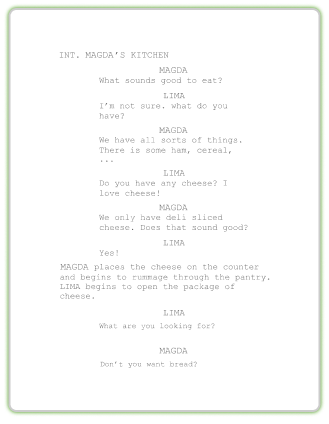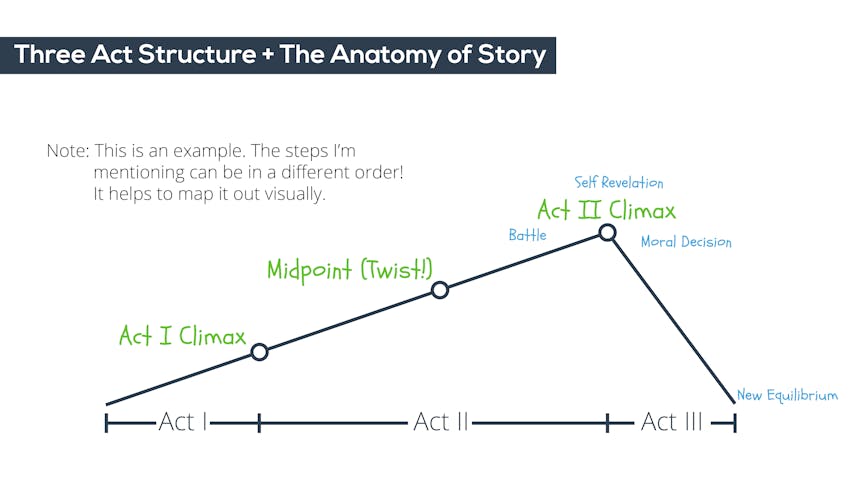With one click
Export a perfectly formatted traditional script.
We’ve teamed up with aspiring screenwriter Ashlee Stormo to show what screenwriting dreams look like in the real world. This week, she summarizes her outlining process, and the 18 steps you can take to get your story in order before you start screenwriting.
Export a perfectly formatted traditional script.


"Hello friends! My name is Ashlee Stormo, and I have been partnering with SoCreate to show you what my life as an aspiring screenwriter looks like, and today I want to share with you how I outline a script. Over time I realized that my problem with storytelling is that I would be writing, and I would be trying to find the ending as I was writing. Then I discovered this book. It’s called “The Anatomy of Story: 22 Steps to Becoming a Master Storyteller,” and it is written by John Truby.
I am not going to cover all 22 steps because he does that, and he does it very well. (You can download a PDF of the steps here.) I highly recommend reading this book. But, I am going to take tips that I learned from reading this book as well as a few tips that I learned in college while I was in screenwriting courses to show you how I created an outline, and how that outline helps me really make a plan for how I want my script to go.
This outline is a list in the form of questions. You can rearrange it if you’re doing a storyline that’s non-linear. You can make a graph. You can take all of these steps and then plot it out on a timeline if you’re visual. Basically, I’m just giving you the tools to adapt to whatever process is best for you."
Alright, so step one is to write yourself a question. It could be, “What would happen if I took premise A from movie A, but mixed it with a totally different premise from movie B?” What does that look like in a new script, in a new story? Or, for the most recent one that I’m working on, I asked myself a question of, “What scares me?” And you should try to answer whatever question you come up with for yourself in one to three sentences. You want this to be very quick. It’s just a way for you to come up with a movie concept if you’re feeling stuck.
Sometimes this takes a few days. I write five sentences and the reason it takes a few days is because you’re going to start from the beginning of what your story is going to look like and figure out everything structurally that happens – who my main character is, what their problem is, why that problem is significant to who they are on the inside, how they solve it and how it ends. Again, quick, concise, you want this to be speedy. This a fast part of the process.
We all know what a premise is. A designing principle is, how are you going to approach that premise in a way that’s unique? How are you going to tell that story different from how anyone else could tell that story? And again, if you are confused about this or any of the rest of the language that I’m using in this video, read this book or look up the terms that I’m saying online. Try to find other resources.
You’ll notice that I am asking that question right now, in the beginning of your script outlining process, because I don’t want you to fall into the hole that I mentioned, that I always fell into where I didn’t know what my hero ended up achieving at the end. So, figure out what your hero is going to learn at the end.
What does she know in the beginning? What does she believe? And then, those should be different, so in that in the end, you’re showing a very clear character arc.
What does she need to overcome this weakness? For example, in this book on page 40, if you’ve seen the movie “Tootsie,” his weakness is that Michael is arrogant, selfish, and a liar. And his need was to overcome his arrogance towards women and to stop lying and using women to get what he wants. So, weakness and need. I like to add in there a note of specifically why your character has trouble overcoming this weakness. If you have that in mind, you can pepper in that reasoning throughout your story.
What is the inciting event that pushes your plot and gets it going? What is that thing that causes everything to happen?
I am turning to page 44 for an example from “Saving Private Ryan.” Need: Hero John Miller must do his duty in spite of his fear. And his desire is that he wants to find Private Ryan and bring him back alive. These are all simple steps. These are all simple questions that you’re answering. But it is important to know them before you get into the storytelling process.
The real key thing here is that you need to make sure that your opponent has a purpose, so it’s not just a character that we really dislike. It’s a character who pushes the plot forward and has a function.
So, you want to give your character a new piece of information. This new information should cause her to change her course of action. So, she had a course of action that she was going to take first. And then, because of this information, her direction changes, although her goal is still the same.
Make a list of the string of events that your character is going to take in order to try and defeat the opponent. This is likely a long list, and this is what Truby refers to as “The Drive.” During “The Drive,” the actions that she’s going through, she might begin to make some immoral decisions, at which point she will have something that Truby refers to as an attack by an ally. So, her ally will call into question, why are you doing that action, that’s not who you are, that’s not what you’re about, you’re doing this wrong. And this is going to help you bring forth your character, and it’s going to help you develop why your character is having that arc. It’s basically the ally telling her that, while her goal is still correct, the way that she’s trying to achieve that goal is wrong.
You’re going to have a second revelation where there’s new information, the character makes a decision, and then they have an obsessive drive. So, that drive we spoke about, that string of events that they do, it’s going to be more frenzied and more obsessive. So, basically, this is where the storyline is starting to get a little more frenzied and pick up. The stakes are rising. And that makes sense, too, because if you’ve seen the plot triangle thing that everyone draws, it goes right along with that.
Your audience is going to get a revelation that the characters don’t get. So, an audience revelation is when you give your audience a little bit of information that your main character is not privy to. And this will create a sense of sympathy for her, or it might create more of a sense of fear about what’s going to happen to this character since she doesn’t know this key bit of information.
I have found that sometimes I don’t need a third revelation, but sometimes you do.
You’re going to have a battle, whether it’s a real battle or just the climax, where the theme of your story should explode.
What is the big change that your character is going to learn from all of these steps that they’ve been taking to try to achieve their goal because again, the whole purpose of story is to see a change of an individual.
Then there’s going to be a moral decision. Does she go route A or route B, and this moral decision proves that the character went through a change, whether it’s for the good or for the bad. That depends on what kind of story you’re writing.
I have an example on page 304 of this book. A new equilibrium is, once the desire and need have been fulfilled, or tragically left unfulfilled, everything goes back to normal. But, there is one big difference. Because of his self-revelation, the hero is either at a higher or lower level.
"I’m a very visual person, and I made this outline where I answered all of these questions that John Truby kind of presented to me. But, I still needed a visual thing to plot it out. So, I made one of the triangular graphs that you see all the time. And I kind of made a pinpoint of where all of these steps take place. I am a novice, as I’ve said in other videos with SoCreate, and who knows if what I’m articulating is actually accurate, but it’s worked for my scripts best."

"Let me know how you outline a script. Is it a little more simple? Is it a little more advanced than how I do it? Do you see any problems with how I outline? Do you have any tips for me? Please share with us in the comments down below.
Make sure you’re following SoCreate on all of their channels. They also have quite a few valuable tools from professionals, whereas I’m just a novice, so make sure you’re looking at that. Thank you so much for watching!"